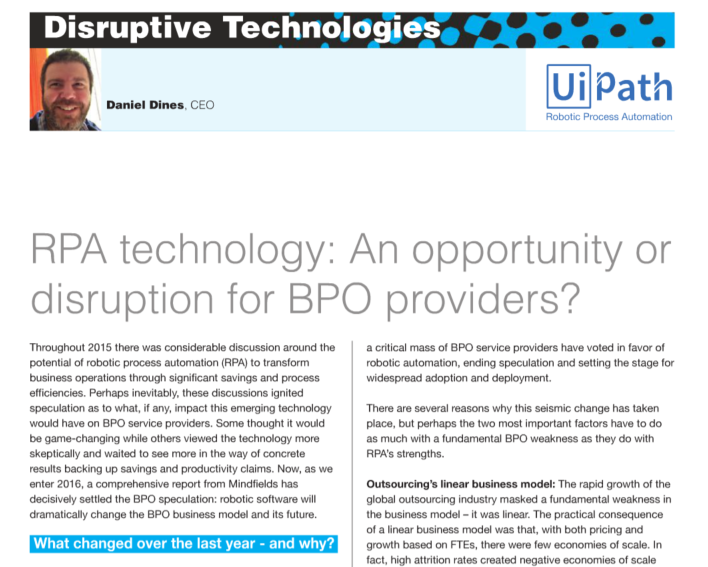RPA Technology: an Opportunity or Disruption for BPO Providers?

Throughout 2015, there was considerable discussion around the potential of robotic process automation (RPA) to transform business operations through significant savings and process efficiencies. Perhaps inevitably, these discussions ignited speculation as to what, if any, impact this emerging technology would have on BPO service providers. Some thought it would be game-changing, while others viewed the technology more skeptically and waited to see more in the way of concrete results backing up savings and productivity claims. Now, as we enter 2016, a comprehensive report from Mindfields has decisively settled the BPO speculation: robotic software will dramatically change the BPO business model and its future.
What Changed over the Last Year – and Why?
The biggest change since 2014 can be described in one word – action. BPO services providers have moved past talking about robotic process automation as a technology with potential benefits; the majority of them are acting on it.
At UiPath, we first began to see this acceleration in RPA adoption in the latter part of 2014 and saw it build during 2015. An example is our engagement with Capgemini’s BPO Automation Program, culminating in a three year product technology partnership. Phase 1 of this program has just completed and Phase 2 is underway.
According to the Mindfields report, 90% of surveyed service providers intend to invest in robotic technology this year and 64% of them have already partnered with robotic vendors to accelerate their positioning in this niche. This means a critical mass of BPO service providers have voted in favor of robotic automation, ending speculation and setting the stage for widespread adoption and deployment.
There are several reasons why this seismic change has taken place, but perhaps the two most important factors have to do as much with a fundamental BPO weakness as they do with RPA’s strengths.
Outsourcing’s Linear Business Model: the rapid growth of the global outsourcing industry masked a fundamental weakness in the business model – it was linear. The practical consequence of a linear business model was that, with both pricing and growth based on FTE’s, there were few economies of scale. In fact, high attrition rates created negative economies of scale when major Indian outsourcing providers found themselves with a 35,000 FTE bench (within a total FTE count of 140,000+) to ensure a sufficient cushion of trained employees for replacement or new account contingencies.
Vanishing Margins: to take an outsourcing contract away from an incumbent provider requires offering a minimum 30% savings over the contract term. For the incumbent, winning a renewal requires offering at least 25% savings over the contract term. The looming challenge for any winner lies in the fact savings have already been extracted from operations during the previous contract term – so where will new savings be found? In the early outsourcing days a mix of new or expanded contracts could be relied upon to bolster weaker margins in mature accounts, but those days are gone.
To further complicate matters, finding new ways to save the customer 25%-30% in operating costs isn’t enough – the service provider has to also achieve an internal operating margin of 20%-25% from the customer engagement to satisfy shareholders. This means the true challenge is actually in the range of finding 45%-55% savings – in the face of inflationary wages and expenses.
As one of the three types of global outsourcing (the others being application and infrastructure services), BPO shares in these two significant business model conundrums. It’s not hard to imagine how the interest of management grew during 2015 when robotic automation showed its claim of significant savings and high scalability was genuine.
The Outlook for Opportunity & Disruption
Certainly robotic software represents a transformational opportunity for business process outsourcing service providers. A principal reason is the technology’s capability to scale dramatically while simultaneously affecting sizeable cost reductions. As discussed earlier, these considerable strengths represent direct answers to deep weaknesses in the outsourcing operating model. However, there are other factors which magnify the opportunity for service providers.
Well Suited Skill Sets: while service providers are aggressively partnering with RPA vendors to quickly incorporate robotic software into solutions, the technology is based on widespread languages such as .Net. This means service providers have deep pools of talent that can scale and master the development of the automated processes run by robots, provided that they get the right training.
Deep Process Knowledge: service providers have deep knowledge of processes within both operational areas (finance & accounting, order management, etc.) and the nuances of industry verticals (insurance claims processing, mortgage loan processing, etc.). This expertise will allow service providers to leverage existing internal and customer process maps to rapidly and effectively model process automation.
Process Optimization Skills: in order to generate customer savings and meet internal margin requirements, service providers learned long ago to turn process expertise into process optimization. Today, by eliminating process inefficiencies – then substantially automating the optimized workflows – service providers are able to release the full savings and scalability potential of robotic software.
Shared Services Model: leading RPA software products emphasize repeatable development techniques, standardization, software reusability and versioned modifications – all of which are conducive to the shared services or GBS models. Global delivery centers are patterned after the shared services model: with skills, resources, practices and methodologies spread across multiple customer teams to maximize efficiencies and utilization. Accordingly, delivery centers will present few obstacles and many advantages to the adoption of this type of technology.
Strong Governance Models: the backbone of the global delivery model is strong governance. The requirement for managing highly scalable deployments of large robot groups is also strong governance. As with the shared services culture within delivery centers, this foundation will enable services providers to aggressively leverage automation robots whilst simultaneously controlling risks and managing change effectively.
Of course, radically changing the service provider business model is about a disruptive an action as can be imagined. This is particularly true in the following areas:
Pricing: suddenly a relatively simple process (rate card + markup, savings levers, future state staffing model, risks & contingencies, etc.) becomes quite complicated. How is a nonlinear solution priced? Will it be by outcome or perhaps by transaction? How does this translate into contractual language?
Staffing: while architecting a global staffing model was always more complicated than pricing, now it becomes even more so. How will teams be structured to incorporate robots in the most efficient manner? Certainly highly automated processes require small teams: managers for work orchestration, business analysts for exception handling, senior analysts/developers for ongoing robot configurations and enhancements.
How will the size of teams change over the life of the contract? Where will the teams be located? When high volumes of automated processes leverage large numbers of robots, aggregated savings will minimize the cost differential between onsite and offshore staffing – which could open up entirely new opportunities for high value, on-shore client-facing roles.
Risks & Contingencies: service providers do not have the luxury of running pilots and applying lessons learned. Instead, after a roughly ninety day RFP response period, they bind themselves contractually to a price, a term and service levels. How will they evaluate relatively high-level RFP documentation and translate this into a multi-year automation strategy and tactical delivery model? Every informational or methodological “hole” will have to be filled with contingencies and risk mitigation; how will this account for the unknowns of a new technology?
Existing accounts: how will service providers address new savings opportunities in accounts covered by existing contracts? Those contracts will almost certainly lack any reference to robotic technology – creating the possibility of highly contentious and disruptive circumstances. For example, a services provider may realize an existing contract can be fulfilled with 40% fewer FTE’s. Ignoring any contractual requirements, will it cut staffing and pocket the large upswing in profitability? Will the customer expect a good faith re-opening of the contract?
What Could Go Wrong?
It would be a mistake for service providers to embrace robotic software without first thinking about what could go seriously wrong as they change – transform might be a better word – the way they do business. Of course, even as such risks are recognized and grappled with, providers have little competitive choice but to continue down the robotic process automation path.
In fact, there is one characteristic of the new services provider business model that appears to have the potential for inflicting serious harm upon the BPO industry.
Previously, the global delivery model protected service operations from any replicative move by its customer base. Yes, a client could set up a captive offshore operations center to capture all the global delivery benefits for itself. But that was a difficult move for most companies and the potential gain rarely justified the investment, disruption and associated risks.
RPA is very different. The technology is accessible; vendors and/or third party advisors are willing and able to support the creation of onsite shared services teams. With those two steps, clients can deploy onsite robotic process automation across the enterprise. Unlike establishing an offshore captive, deploying an on-site shared services team is well within the capability – and risk appetite - of many services provider customers.
Service providers have to ask themselves how long their customers will allow them to keep half (or more) of all the savings this technology will produce. Perhaps clients will be content to leave money on the table while robotic automation proves itself beyond all doubt. After that point, services providers will need to develop a compelling value proposition to keep customers from bringing process automation in-house.
Case Study
Capgemini, a global BPO service provider, is in a three-year RPA product partnership with UiPath for their BPO Automation Program. Phase one, the “GUI Automation Solution”, began in late 2014. Since mid-2015 it has been rolled out globally by the BPO Delivery Excellence team. The phase has proven RPA transforms the BPO business model.
At the December 2015 London IRPA conference, Dr. Marcus Esser, head of Capgemini’s BPO IT Innovation Center, presented Phase one results:
Manual client invoice processes taking 600 seconds were reduced to 180 seconds
Process and sub-process work was completely taken away by robots
Phase one of Capgemini’s BPO Automation Program confirmed RPA technology’s potential for dramatic savings and performance impact: a typical pilot engagement showed weekly savings of 25 people days within 30 days of deployment.
Dr. Marcus Esser said Capgemini’s BPO delivery teams automated processes and sub-processes in five working days: “Requirements-gathering started on Monday and by Friday automation was ready for production.”
At the London IRPA conference, Capgemini outlined formal RPA governance in three areas:
Change Control, with a methodology to maintain alignment of process changes with automation changes.
Automation QA, with a production release review based on formal automation standards.
Automation Service Levels, by means of real-time reporting and dashboard graphics.

Founder and CEO, UiPath
Get articles from automation experts in your inbox
SubscribeGet articles from automation experts in your inbox
Sign up today and we'll email you the newest articles every week.
Thank you for subscribing!
Thank you for subscribing! Each week, we'll send the best automation blog posts straight to your inbox.



